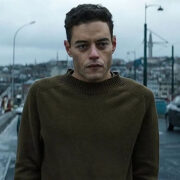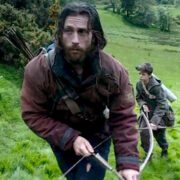Sundance 2020: Interview With Cinematographer Eric Branco Of The 40-Year-Old Version

Wilson is a cinema enthusiast based out of Toronto, Canada.…
Following his phenomenal work as the cinematographer for 2019’s criminally underrated Clemency, Eric Branco returns to Sundance again this year with The 40-Year-Old Version. Shot entirely on film and in black and white, Branco uses a classical approach to filmmaking in order to highlight a uniquely nostalgic aesthetic. The 40-Year-Old Version is sure to be a technical marvel that is best experienced on the big screen.
Wilson Kwong for Film Inquiry: What initially attracted you to this particular project?
Eric Branco: I think what attracted me first was that it was a movie told from a point of view that we don’t often get to hear from. I’m from New York, the director is from New York, and the movie felt like it was for all the people I know but don’t often see on screen.
Can you talk about why it was important to shoot this movie on film and in black and white?
Eric Branco: Yes, the film was shot on 35 millimeter film in black and white, and [shooting on film] was how movies used to be shot up until the last 10 years or so. Something we talked about was representation and seeing ourselves on camera, and how black Americans never got a chance to see themselves in the glamorous Hollywood black and white kind of way, whereas most other groups have. That was something that we were acutely aware of, and we tried to make a great black and white film starring black people.
So I’m guessing the decision to shoot in black and white was already made during the planning stages.
Eric Branco: Yes, it was black and white before I even came on board.
And how does shooting in black and white change how you do your filming?
Eric Branco: I think the biggest challenge is that you need to train yourself to see in black and white. It’s almost kind of like learning another language. As a DP (director of photography), you’re intimately involved in the whole process. The production designer is coming to you, the costume designer is coming to you, and you have a hand in a lot of choices that are being made. When they show you an orange and blue dress, you need to know what that’s going to look like in black and white. Similarly, when you’re lighting, you need to be able to see what it will look like, which I think is a skill set that [is declining] as people shoot more and more on digital and trust the monitor. When you’re on set, it’s easy and pretty accurate to light something and look at the monitor and say, “I like the way it looks. I don’t like the way it looks,” and then adjust based on that rather than having an overall game plan in your head, and trusting that and knowing what it will look like later.
And by shooting on film instead of digital, what do you think was the biggest impact this had on the film’s overall aesthetic?
Eric Branco: I think film is beautiful and it has its own look and its own aesthetic. I think it was important for us to make one more New York movie in black and white that was our New York, but shown the way that the New York of the movies is shown, if that makes sense.
I would also assume that the best place to see this would obviously be in the theatre on a big screen?
Eric Branco: Oh God, yes. Anything I shoot, film or not, I want people to see on the big screen. I think there’s something special about sitting in a dark room with a bunch of strangers and letting all your emotions out, but I’m also of the mentality that I’m happy if you’re seeing my work anywhere. See it on the big screen, but if you can’t, see it on the airplane backseat.
Since people don’t really shoot on 35mm anymore, was that something that you had to learn from scratch, or did you have some experience with it before already?
Eric Branco: It’s interesting, I kind of come from a split generation. When I first started learning, everything was film. Then when I first started working, I worked my way up through the grip electric department before I was a DP. And when I worked in the lighting department, again, everything was film. It was one of these things where when you take a step up to a new position, you kind of tumble all the way back down to the lowest level of that position. As a gaffer, I was working on movies about the size that I’m shooting now.
But once I started DPing, suddenly I was back to shooting student films and tiny little shorts, and those were all done digitally. It was this kind of thing where all of my training was on film, but I was never really given the opportunity to shoot on film because by the time I worked my way back up, the transition had happened already and it was all digital. But I do shoot an obscene amount of film on film, so I’m very comfortable with it. That’s a skill set I have and it felt very comfortable and homey.
Do you find shooting on one format versus the other to be more difficult? It sounds like shooting on digital might be easier just because you get that instant feedback and can see exactly how it looks right away.
Eric Branco: It depends. I mean, sometimes not having feedback is easier, right? If you’re talking purely from an on set perspective, I think shooting on film is easier because people aren’t picking apart the image at every second. A lot of times when you’re shooting digital, a lot of breath is wasted at the monitor and people pick things apart. “Should it be brighter over here? Should it be darker over there?” On film, a lot of that goes away and people really focus on maintaining their craft at a high level, because you don’t have the crutch of knowing if it’s going to work or not work. But I think with digital it’s easy to take a risk because you can see if that risk is going to work or not. If it doesn’t, you try something else. Film doesn’t give you that option. With film, you need to bring your A-game the entire time.
As a cinematographer, when you’re shooting a film that’s very dark and serious (like Clemency) versus something more light and comedic (like The 40-Year-Old Version), does that factor into how you approach your work?
Eric Branco: It’s interesting because a lot of the work I did on Clemency was really based around making sure that as the cinematographer, I was not doing anything that was going to pull these actors out of these amazing performances. I wanted to do everything in my power to keep these actors in that head space and allow them to stay in this world and do the best work they could. Interestingly enough, shooting comedy is very similar too. When people are in a groove and rhythm and everyone in the room is being funny and cracking jokes, I don’t want to disrupt that either. From a photographic perspective, I think the movies look very different, but from a dogmatic standpoint, I think they’re very similar in that both films were really about getting out of the way of the performances.
The 40-Year-Old Version will have its world premiere at the Sundance Film Festival on January 25, 2020.
Does content like this matter to you?
Become a Member and support film journalism. Unlock access to all of Film Inquiry`s great articles. Join a community of like-minded readers who are passionate about cinema - get access to our private members Network, give back to independent filmmakers, and more.
Wilson is a cinema enthusiast based out of Toronto, Canada. He escapes from his day job by writing random thoughts about cinema on the internet. Although he has a longstanding penchant for Hong Kong cinema, he considers himself to be an advocate for Asian cinema in general. He has been attending the Toronto International Film Festival every year since 2005, and more of his work can be found on his website: www.wilson-kwong.com.












